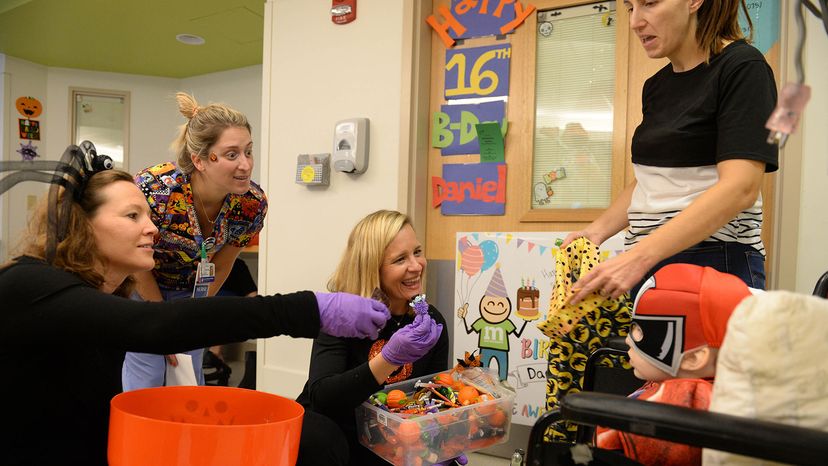 “Molly Shrewsberry (L) and Tracy Stevens hand out Halloween candy at Boston Children’s Hospital, Oct. 31, 2018. Darren McCollester/Getty Images for Boston Children’s Hospital
“Molly Shrewsberry (L) and Tracy Stevens hand out Halloween candy at Boston Children’s Hospital, Oct. 31, 2018. Darren McCollester/Getty Images for Boston Children’s Hospital
Did you hear about the little girl who bit into a candy bar and died because a stranger had tainted it with poison? Maybe in the story you heard, a little boy bit into an apple and cut his mouth on a razor blade. The stories of evil strangers tainting Halloween candy and apples with poison, glass and razor blades have prevailed for several decades. But are they true?
Although there have been a few reports of candy tampering over the years, nearly all of them have been debunked as hoaxes or pranks. Until 2000, there hadn’t been a single proven incident in which a child was injured by Halloween candy from a stranger. That Halloween, James Joseph Smith of Minneapolis was charged with one count of adulterating a substance with intent to cause death, harm or illness after he put needles into candy bars and handed them out. One child was pricked with a needle when he bit into a candy bar, but neither he nor any other children were seriously injured. The idea of tainted candy from a stranger may have started with a 1964 incident involving a New York homemaker named Helen Pfeil. Irritated at the idea of handing out free candy to older kids, Pfeil gave out packages of steel wool pads, dog biscuits and poison ant buttons. Although she made it clear that her "goodies" were inedible, Pfeil was charged with endangering children.
There have been at least two confirmed deaths linked to tainted Halloween candy, but strangers didn’t cause them. In a 1970 case, family members sprinkled a 5-year-old child’s candy with heroin to hide the fact that he’d gotten into his uncle’s drug stash. In the other case, which occurred in 1974, a man named Ronald Clark O’Bryan of Houston, Texas, laced his son’s candy with cyanide and the child died. The motive was a big insurance policy that O’Bryan had taken out on his son. To make the poisoning appear random, O’Bryan also poisoned his daughter’s candy and the candy of three other children. None of them ate it, however. He was eventually convicted of murder and died by lethal injection.
Although these were isolated incidents, the idea of candy tampering spread through cities and suburban neighborhoods, making parents fearful about the contents of their children’s Halloween baskets. The candy-tampering scare reached its height in 1982, when seven people in the Chicago area died after taking tainted cyanide-laced Tylenol capsules. About 40 communities actually went so far as to ban trick-or-treating. That year, the candy industry set up a telephone hotline to collect police reports of candy tampering, but it hasn’t received a single verified report of a child being seriously hurt by tainted candy from a stranger.
Despite the lack of evidence, parents still sometimes panic over candy that looks strange. Usually the appearance is due to variations in the manufacturing process or in storage. Chocolate can appear gray when the candy has been exposed to too much heat or moisture (See Why does chocolate turn gray sometimes?
Although the odds of someone actually tampering with Halloween candy are slim-to-none, most experts recommend that parents check their kids’ Halloween haul before letting them eat it. Although you don’t need to have your candy x-rayed at the local hospital or airport (and many of them offer the service), you should throw out any candy that’s unwrapped, homemade (unless you know the person who made it) or has a torn wrapper, just to be on the safe side.
For more information about candy, Halloween and other related topics, check out the links on the next page.
Lots More Information
Related HowStuffWorks Articles
- How Halloween Works
- How Chocolate Works
- Why does chocolate turn gray sometimes?
- How do they make cotton candy?
- How do Pop Rocks Candy work?
- How do they make marshmallows?
More Great Links
- Intelihealth: Halloween Safety
- Snopes.com: Halloween Poisonings
- Inside a Candy Factory
- National Confectioners Association
- Variations in Candy Guide































